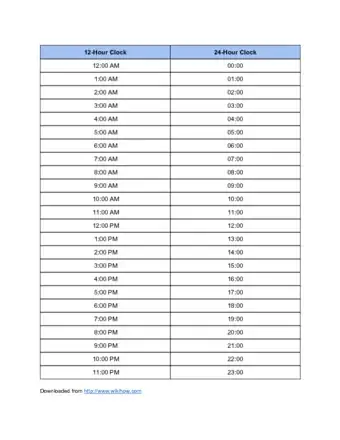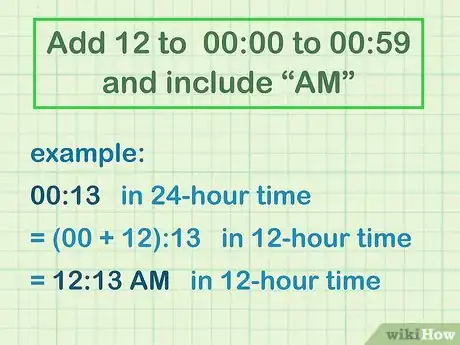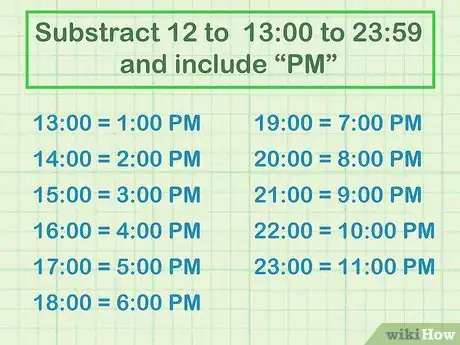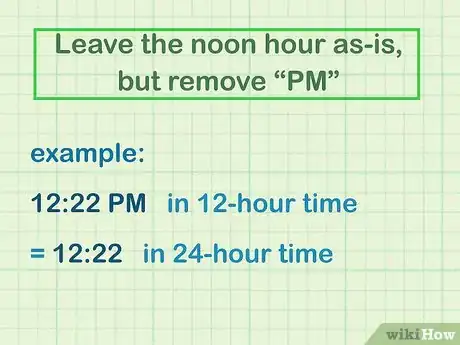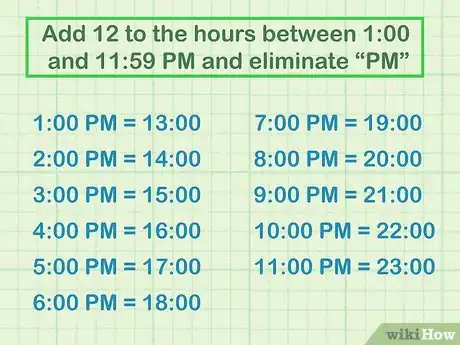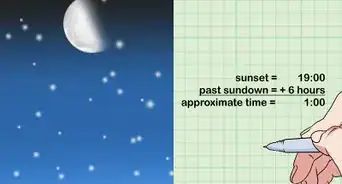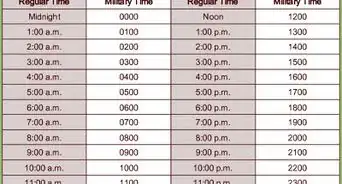This article was co-authored by wikiHow staff writer, Sophia Latorre. Sophia Latorre is a Content Manager on the wikiHow team. Before joining wikiHow, Sophia worked as a technical editor and was published in six International Energy Agency (IEA) Wind Annual Reports. Now, she writes, edits, and reviews articles for the wikiHow Content Team, working to make the content as helpful as possible for readers worldwide. Sophia holds a BA in English from Colorado State University.
This article has been viewed 1,401,742 times.
Learn more...
If you’ve ever been stumped when you see a clock read something like 14:24, it's probably because you’re unfamiliar with 24-hour time. This form of timekeeping is commonly used in the U.S. military, Europe, and other parts of the world. Fortunately, it’s super simple to convert from 24-hour time to 12-hour (or standard) time and back. Remember that you only need to convert the hours—the minutes always stay the same.
Steps
Time Conversion Cheat Sheet
Converting 24-Hour Time to 12-Hour Time
-
1Add 12 to the first hour of the day and include “AM.” In 24-hour time, midnight is signified as 00:00. So, for midnight hour, add 12 and the signifier “AM” to convert to 12-hour time. This means that, for example, 00:13 in 24-hour time would be 12:13 AM in 12-hour time.[1]
Did You Know?
The abbreviations “AM” and “PM” are Latin in origin. “AM” stands for “ante meridiem” which means “before noon” while PM stands for “post meridiem” which means “after noon.”[2] -
2Include the signifier “AM” for times between 1:00 and 11:59. Since 24-hour times moves from 00:00 (midnight) to 1:00, all you have to do is add “AM” to the time from 1:00 up until 11:59. You can also eliminate any leading zeroes. For instance, 06:28 in 24-hour time is equivalent to 6:28 AM in 12-hour time. This means that:[3]
- 01:00 = 1:00 AM
- 02:00 = 2:00 AM
- 03:00 = 3:00 AM
- 04:00 = 4:00 AM
- 05:00 = 5:00 AM
- 06:00 = 6:00 AM
- 07:00 = 7:00 AM
- 08:00 = 8:00 AM
- 09:00 = 9:00 AM
- 10:00 = 10:00 AM
- 11:00 = 11:00 AM
Advertisement -
3Add the signifier “PM” for 12:00 to 12:59. For the noon hour, simply add “PM” to the end of the 24-hour time to make it 12-hour time. So, for example, 12:45 would become 12:45 PM.[4]
-
4Subtract 12 from 13:00 to 23:59 and include “PM.” For the hours after noon, subtract 12 hours from the 24-hour time. Then add “PM” at the end. For instance, to convert 14:36 to 12-hour time, subtract 12, which is 2:36, then add “PM.” There’s no need to include a leading zero for single-digit numbers in 12-hour time. Therefore:[5]
- 13:00 = 1:00 PM
- 14:00 = 2:00 PM
- 15:00 = 3:00 PM
- 16:00 = 4:00 PM
- 17:00 = 5:00 PM
- 18:00 = 6:00 PM
- 19:00 = 7:00 PM
- 20:00 = 8:00 PM
- 21:00 = 9:00 PM
- 22:00 = 10:00 PM
- 23:00 = 11:00 PM
Changing 12-Hour Time to 24-Hour Time
-
1Use 00:00 to signify midnight in 24-hour time. Rather than using “12:00” twice in a 24-hour period, like in 12-hour time, 24-hour time uses “00:00” for the midnight hour. That means all you need to do is record the minutes. For example, 12:30 AM becomes 00:30.[6]
Did You Know?
There’s no 24:00 in 24-hour time since it moves from 23:00 (11:00 PM) to 00:00 (12:00 AM). -
2Eliminate “AM” for the hours between 1:00 and 11:59 AM. Changing the hours between midnight and noon from 12-hour time to 24-hour time is super simple. All you have to do is take away the “AM” signifier. If the hour number is a single digit, add a leading zero. So, for example, 6:00 AM is 06:00 and 10:15 AM is 10:15. Therefore:[7]
- 1:00 AM = 01:00
- 2:00 AM = 02:00
- 3:00 AM = 03:00
- 4:00 AM = 04:00
- 5:00 AM = 05:00
- 6:00 AM = 06:00
- 7:00 AM = 07:00
- 8:00 AM = 08:00
- 9:00 AM = 09:00
- 10:00 AM = 10:00
- 11:00 AM = 11:00
-
3Leave the noon hour as-is, but remove "PM." You don't need to do anything to change 12:00 PM to 12:00 in 24-hour time, except for eliminate the "PM" signifier. So, 12:22 PM would simply be 12:22, for instance.[8]
-
4Add 12 to the hours between 1:00 and 11:59 PM and eliminate "PM." For the afternoon, evening, and night hours, simply add 12 to the 12-hour time to convert it to 24-hour time. Also, eliminate “PM.” That means that 2:57 PM would become 14:57 and 11:02 would become 23:02. Therefore:[9]
- 1:00 PM = 13:00
- 2:00 PM = 14:00
- 3:00 PM = 15:00
- 4:00 PM = 16:00
- 5:00 PM = 17:00
- 6:00 PM = 18:00
- 7:00 PM = 19:00
- 8:00 PM = 20:00
- 9:00 PM = 21:00
- 10:00 PM = 22:00
- 11:00 PM = 23:00
Community Q&A
-
QuestionWhat time is 00:20hrs?
 Community AnswerAnd 00:20 means 12:20 at midnight.
Community AnswerAnd 00:20 means 12:20 at midnight. -
QuestionHow do I change 15:15h into 12 hour time?
 Community AnswerThat would be 3:15 p.m.
Community AnswerThat would be 3:15 p.m. -
QuestionDoes 12:45 mean night or afternoon?
 Community AnswerIt could mean either. If it says 12:45 a.m., that means it's night, 45 minutes after midnight. If it says 12:45 p.m., it is the afternoon, 45 minutes after noon.
Community AnswerIt could mean either. If it says 12:45 a.m., that means it's night, 45 minutes after midnight. If it says 12:45 p.m., it is the afternoon, 45 minutes after noon.
References
- ↑ https://www.mathsisfun.com/time.html
- ↑ https://www.militarytime.us/what-do-am-and-pm-stand-for/
- ↑ https://www.mathsisfun.com/time.html
- ↑ https://www.mathsisfun.com/time.html
- ↑ http://www.onlineconversion.com/date_12-24_hour.htm
- ↑ https://www.nlacrc.org/home/showdocument?id=746
- ↑ https://www.bbc.com/bitesize/guides/z3rk7ty/revision/2
- ↑ http://militarytimechart.com/
- ↑ https://www.nlacrc.org/home/showdocument?id=746
About This Article
24-hour time, sometimes called military time, is a way of measuring a full 24-hour day instead of splitting it up into two 12-hour shifts. To go from 24-hour time to 12-hour time, keep in mind that the 24-hour day starts at 00:00 instead of 12:00 AM. However, the minutes are still the same. For the first hour of the day, simply add a “12” where you see the initial 0 to convert to 12-hour time. For instance, 00:25 in 24-hour time is 12:25 AM in 12-hour time. After that, the rest of the hours of the morning look the same. For any time after 12:59 in 24-hour time, subtract 12 to get the 12-hour time. For example, if the time is 17:00, subtract 12 hours to get 5:00 PM in 12-hour time. For tips on how to convert back from 12-hour time to 24-hour time, read on!
